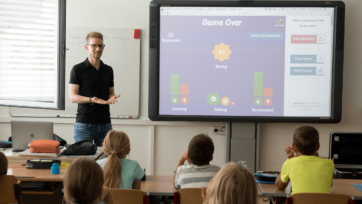Flipped Classroom: The Importance of Home Learning in Modern Education
The Importance of Home Learning in Modern Education
Classrooms today are busy places; there’s a lot to get through, whether that’s curriculum content or simply the logistics and admin of a school day. Unsurprisingly, both teachers and students are pressed for time. Home learning, when approached correctly, can go some way to combating these difficulties, allowing students to ‘bulk up’ on the content required during individual study before applying their new understanding to new situations under teacher supervision. This then, has implications for the types of resources provided to students to allow them to develop a deep understanding of your key messages. Before we dive into these implications, let’s look at the concept of a Flipped Classroom:
Simply put, a Flipped Classroom is when students access key content outside of the classroom, digest it, familiarise themselves with the main messages, etc, then come together in a collaborative environment to debrief, discuss, analyse and evaluate the content and apply any learnings to a new situation. Basically, the reverse of traditional learning, where key content is introduced in the classroom and homework is used as an application of learning.
What do students need for a Flipped Classroom to function well?
- A broad range of sources to support critical thinking, evaluation and summative skills. To fully grasp an understanding of a topic or theme while studying independently, and cater to diverse learning styles, students need access to a range of sources that discuss the key content.
- A learner-centric approach. In the Flipped Classroom students have agency over their learning to fully express their understanding of the material and key messages in a manner that is meaningful to them.
- Continual and constructive feedback. Good interactive learning platforms can be programmed to provide students with continual feedback, allowing an individualised learning experience which doesn’t hinge on the attendance of a classroom teacher.
What does this mean for my resources?
- A range of resources is important. Consider how to incorporate video, text, interactive learning and quizzes to cater to different learning styles and allowing all students to access the content needed to understand your key messages.
- Link to external sources. The 21st Century classroom aims to equip students with a range of workforce-ready skills, including critical thinking, digital literacy and analysis. Consider how you can support your key messages or extend the themes of your resources through external links, supporting websites, online games, etc, as this will help students to develop an understanding of how these key messages fit into their wider world.
- Assessment activities should embrace the understanding that students work and learn in different ways. Instead of a prescriptive outcome, try a criteria for success allowing students to produce their work in ways that are meaningful to them.
- Consider how to use digital tools to track and assess learning and provide instant feedback to students in the form of quizzes and Learning Management Systems.
Next steps?
- Audit your existing resources and review in line with the above recommendations
- Take steps to understand what home learning resources are already available to support the Flipped Classroom
- Update or create new resources to support effective home learning
Don’t have the time or expertise? Contact Kimberlin Education and let us help you ensure your resources are useful and relevant for all students and teachers today.




